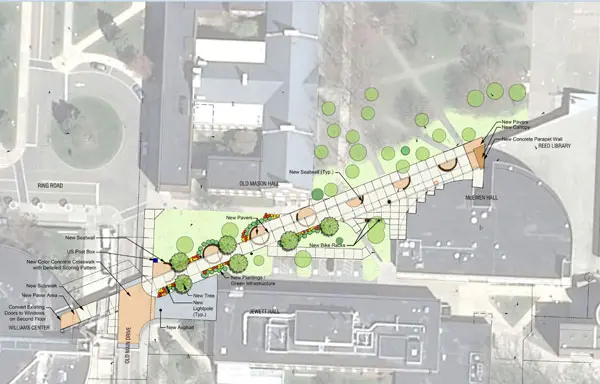



Whether they stood on it, or under it, Fredonia students and alumni needed just one look at the spine bridge to reminisce moments big or small: whether it was a major event, a chance encounter, or memories of a long-lost classmate. The spine bridge had been a visual component of the modern Fredonia campus since it was built in 1969.
Over the years, while all those memories were being made, the concrete bridge slowly, and steadily, deteriorated. There was substantial denigration of the interior materials of the spine bridge, accelerated by harsh winters. The estimated overall budget to remove and reconstruct the bridge was $4.2 million. The decision was made earlier this year to focus precious SUNY Construction Fund dollars towards improving and renovating academic buildings to keep Fredonia’s most vital mission — educating students — strong.
“At a time of challenging finances, and when construction funds are at a premium, we need to be strategic in deciding where that money is spent,” said Fredonia President Virginia Horvath. “We have had no new capital project funds for several years, so we are using the limited critical maintenance funds to improve and modernize the most critical structures for learning and other student experiences.”
Another consideration in removing the spine bridge was the design of the campus. The physical footprint of the campus has changed since the spine bridge was built. The spine was designed as the central pedestrian walkway through campus, but that is no longer the case. The main entrance to Reed Library was relocated from the elevated spine to the ground level in 1991, and library access from the spine bridge was eliminated for security reasons. With the completion of the tunnel access between Maytum Hall, Reed Library, and McEwen Hall, and the spine bridge’s closure in winter months, it was no longer being used as originally intended.
The university announced last spring a two-step process to remove the bridge and repair the area underneath it. The first phase started right after Commencement, when Union Concrete and Construction of West Seneca demolished the walkway, using an environmentally-friendly process.
“The company is recycling the rebar inside the concrete,” said Markus Kessler, director of Facilities Planning. “The concrete is also being taken to a nearby site where it will be pulverized and recycled.”
Phase two of the process will happen in the summer of 2017, when a grade-level pedestrian walkway will be developed in place of the temporary asphalt surface. A diverse committee that includes current students, alumni, faculty, and administrators is reviewing designs for the walkway, the entrance to McEwen, and the former connection to the second floor of the Williams Center. The goal is to create a pedestrian walkway that honors the aesthetic intentions of original architect, I.M. Pei and Associates. While there have been calls for a covered walkway, finances simply won’t allow for it, and the SUNY Construction Fund has been clear that such projects would not be approved.
“When looking at the possibility of creating a simple canopy for the new pedestrian walkway vs. reconstructing the spine, we found that only a tensile fabric structure would be more viable than any other canopy type,” said Kessler. “However, this type of structure required a sufficient number of anchorage and supports to handle the imposing loads and along with the cost of additional engineering, steel fabrication and installation difficulties made this option an uneconomical solution.”
Facilities Planning estimated the overall project budget to build such a structure would be $3.5 million, which approaches the amount of money that would have been required to completely rebuild the original spine bridge. In addition to the excessive cost, a tensile fabric structure would not incorporate any of the I.M. Pei concepts to recreate the spine’s aesthetic intent, which is a goal for this project.
“The number of nostalgic posts on social media revealed that some alum and current were disappointed to see the spine bridge removed,” said President Horvath. “However, maintaining safety is an important priority, even as we move forward with sustaining the architectural feel of the evolving campus. With the spine bridge cleared, there is now a clear view to architectural features of McEwen that were obstructed before. There is an openness near the entrance to the Williams Center that makes pedestrian traffic easier to see for drivers, including trucks bringing supplies to the loading dock. The view into the quad between Mason Hall and Reed Library is inviting. The designs for the surface that will be build next summer will show where the columns were and have seating areas and landscaping that reflect the sense of welcome here. I’ve been grateful to the project and design teams and look forward to seeing the next phase completed.”